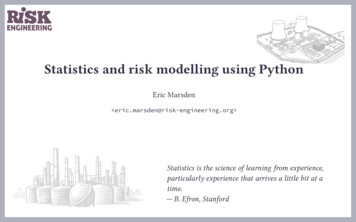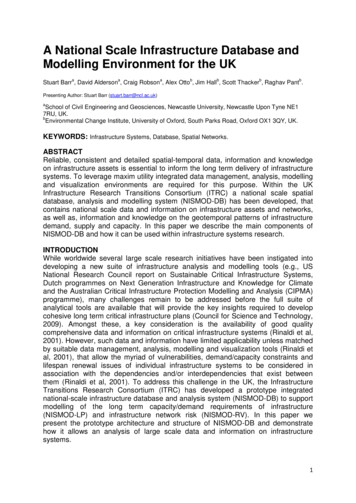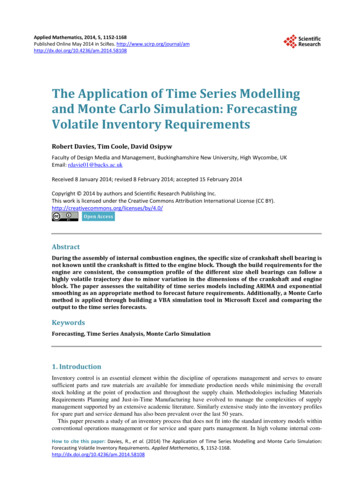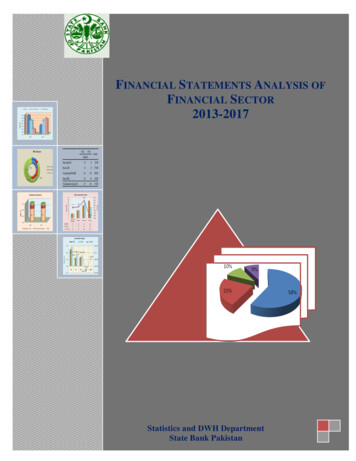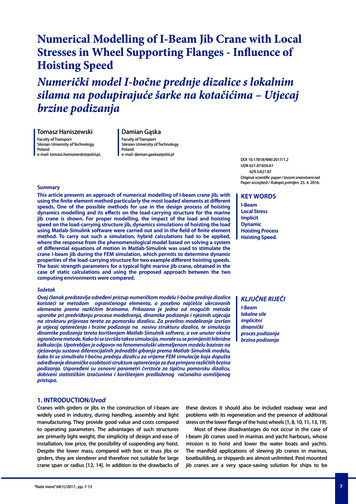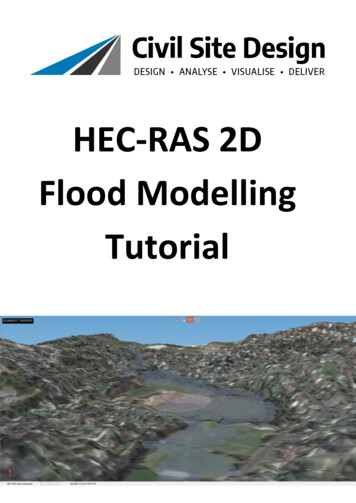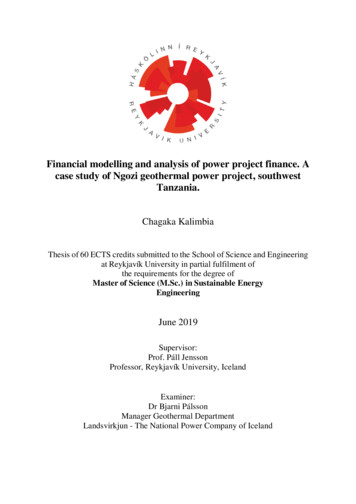
Transcription
Financial modelling and analysis of power project finance. Acase study of Ngozi geothermal power project, southwestTanzania.Chagaka KalimbiaThesis of 60 ECTS credits submitted to the School of Science and Engineeringat Reykjavík University in partial fulfilment ofthe requirements for the degree ofMaster of Science (M.Sc.) in Sustainable EnergyEngineeringJune 2019Supervisor:Prof. Páll JenssonProfessor, Reykjavík University, IcelandExaminer:Dr Bjarni PálssonManager Geothermal DepartmentLandsvirkjun - The National Power Company of Iceland
Financial modelling and analysis of power project finance. Acase study of Ngozi geothermal power project, southwestTanzania.Chagaka KalimbiaThesis of 60 ECTS credits submitted to the School of Science and Engineeringat Reykjavík University in partial fulfilment ofthe requirements for the degree ofMaster of Science (M.Sc.) in Sustainable Energy EngineeringJune 2019Student:Chagaka KalimbiaSupervisors:Prof. Páll JenssonExaminer:Dr Bjarni Pálsson
AbstractThis study undertook Excel-based financial modelling which entailed construction of ananalytical instrument that performs detailed financial and economic analysis for a 30 MWNgozi geothermal power project investment over its economic useful life. The tool facilitatesmaking the most important financial decisions and solves complex questions about the futureperformance of an investment. The new bankable project is transacted using project financestructure with a 70% debt share and 6% interest arrangement in long-term debt financing. Themodel was built to quickly process a comprehensive list of project input assumptions toestablish investment key performance indicators (KPIs) from the detailed analysis of projectedcash flows. Results of the analysis are useful to the key power project stakeholders namelylenders, sponsors and off-taker in evaluating the attractiveness of the investment andsubsequently facilitate making strategic decisions required for the project implementation. Thedeterministic KPIs results were subjected to the risk analysis to mirror a range of data variationsand thus account for future uncertainties of the cash flows. The probabilistic estimation ofproject CAPEX made with a 90% confidence level amounts to 129 million USD. The projectrequired a total of 21 million USD to meet the lender's fees, interest during construction andinitial funding of reserve accounts. The project yielded an equity and project NPV of 24 millionUSD and 62 million USD respectively. The IRR of the project was 10% calculated WACCof 6% while the IRR of equity was 17% 10% of expected return on equity. The model yieldedlender’s ADSCR of 1.4, LLCR of 2.1 and PLCR of 1.9, all the cover ratios above theirminimum requirement, indicating the robustness and ability of project cashflow to service andrepay debt. The project produced the LCOE of 60 / MWh with the exclusion of the effects oftaxes on costs. The risk analysis indicated the price of electricity and energy production to bethe most sensitive parameters to the KPIs results. Overall, the model analysis demonstrated theviability of geothermal power project investment to the key project stakeholders.Keywords: modelling, project finance, PPP, geothermal, Ngozii
Table of ContentsAbstract ------------------------------------------------- iList of Figures ---------------------------------------- iiiList of ----------------------------------------------- ivAcknowledgement ------------------------------------ v1. Introduction -------------------------------------- 11.1. Background introduction ------------------ 21.2. The need for Public-Private Partnership (PPP) arrangement --------------------------- 21.3. The need for project finance -------------- 31.4. The need for financial modelling for project finance ------------------------------------ 31.5. Research objectives ------------------------ 41.6. Research questions ------------------------ 41.7. Thesis -------------------------------------- 42. Public-Private Partnerships (PPPs) ------------ 72.1. PPP versus public-sector procurement -- 82.2. Structures of PPP -------------------------- 92.3. PPP payment structure ------------------- 102.4. PPP contracts ------------------------------ 102.5. PPP in the power sector ------------------ 112.6. PPP in geothermal power project ------- 112.7. PPP power tariff structure --------------- 123. Project financing structures ------------------- 163.1. Principal financing models -------------- 163.2. Project finance ---------------------------- 183.3. Risk allocation ---------------------------- 304. Projects financial appraisal -------------------- 334.1. Payback Period (PP) method ------------ 334.2. Net Present Value (NPV) ---------------- 354.3. Rate of return methods ------------------- 394.4. Profitability index ------------------------- 434.5. Financial ratio analysis ------------------- 444.6. Levelized Cost of Electricity (LCOE) -- 525. Financial risk analysis ------------------------- 545.1. Sensitivity analysis ----------------------- 545.2. Break-even analysis ---------------------- 565.3. Scenario analysis -------------------------- 575.4. Simulation analysis ----------------------- 576. Financial modelling ---------------------------- 606.1. Project finance model -------------------- 616.2. Purpose and uses of the model ---------- 626.3. Model development phase --------------- 636.4. Steps in building a financial model ----- 636.5. Model design principles, layout and components --------------------------------------- 646.6. Model components ----------------------- 677. A case study of the geothermal field. -------- 787.1. Geothermal energy, development and utilization --------------------------------------- 787.2. Project description ------------------------ 847.3. Summary of model project parameters - 928. ------------------------------------------------- 958.1. Model inputs and assumptions ---------- 95ii
8.2. Model calculations ------------------------ 988.3. Model results and graphs ---------------- 988.4. Project risk analysis -------------------- 1058.5. Project finance deal summary --------- 1089. Conclusion ------------------------------------ 110References ------------------------------------------ 113Appendices ----------------------------------------- 118APPENDIX I : Optimization of financing costs ------------------------------------------------- 118APPENDIX II : Resource potential and power plant production (MWh) --------------------- 118APPENDIX III : Investment and financing worksheet ------------------------------------------ 119APPENDIX IV : Income statement worksheet - 120APPENDIX V : Balance sheet statement ------- 121APPENDIX VI : Cash flow statement ---------- 122List of FiguresFigure 1: Principal components of capacity charge ------------------------------------------------ 13Figure 2: Principal components of energy charge (Source: CLDP, 2014) ---------------------- 14Figure 3: Host government financing structure (Source: CLDP, 2016) ------------------------- 17Figure 4: Developer financing structure (Source: CLDP, 2016) --------------------------------- 18Figure 5: Project bankability ----------------------- 19Figure 6: Project finance arrangement (Source: CLDP, 2016) ----------------------------------- 21Figure 7: Project finance structure (Source: Finnerty, 2013) ------------------------------------- 23Figure 8: Power project finance participants and contractual structure ------------------------- 23Figure 9: Project finance phases with dynamic of cumulative operating cash flows for aninvestment project (Source: Gatti, 2013) --------- 25Figure 10: Project finance cash flows waterfall -- 27Figure 11: Cost project finance versus non-project financing techniques ----------------------- 28Figure 12: NPV profiles ---------------------------- 40Figure 13: Sample sensitivity spider plot (Source : Whitman and Terry, 2012) --------------- 55Figure 14: Model stage development flow chart - 63Figure 15: Steps in building a financial model (Source: Sengupta, 2004) ---------------------- 64Figure 16: Typical project finance model layout and components ------------------------------- 65Figure 17: Model components and their relationships (Source: Jensson, 2006) ---------------- 66Figure 18: Balance sheet assets components ----- 69Figure 19: Balance sheet liabilities components - 70Figure 20: Cash flow production cycle (Source: Higgins, 2016) -------------------------------- 73Figure 21: Standard presentation for the statement of cash flows (Source : Atrill and McLaney,2017) -------------------------------------------------- 74Figure 22: Response of plates to compression and tension --------------------------------------- 79Figure 23: Schematic model of a hydrothermal geothermal system ----------------------------- 80Figure 24: Modified Lindal diagram showing applications for geothermal fluids (Source:DiPippo, 2016) --------------------------------------- 81Figure 25: Geothermal worldwide Installed Capacity --------------------------------------------- 82Figure 26 : Tectonic map of Eastern Africa showing East African Rift System and earthquakefocal mechanisms (Source: TGDC, 2017) -------- 83Figure 27 : Location of Ngozi geothermal field, SW Tanzania (Source: MEM, 2012) ------- 84Figure 28 : Tanzania power installed capacity (Source: TanzaniaInvest, 2016) --------------- 85Figure 29 : Schematic geological conceptual model for Ngozi volcano ------------------------ 87Figure 30: Project phases, costs, risk profile and bankability ------------------------------------ 88Figure 31: Models of geothermal power development in the world ----------------------------- 89iii
Figure 32: Simplified single-flash power plant schematic ---------------------------------------- 90Figure 33: Histogram simulation results for total project CAPEX ------------------------------- 95Figure 34: CAPEX ------------------------------ 96Figure 35: Resource potential and production profile --------------------------------------------- 97Figure 36: Snapshot of calculated FCFP, FCFE and KPIs ---------------------------------------- 99Figure 37: Project and Equity Cash flows -------- 99Figure 38: Accumulated NPV -------------------- 100Figure 39: IRR of project and equity ------------ 101Figure 40: ERR of project and equity ----------- 101Figure 41: Project and equity discounted pay payback periods -------------------------------- 102Figure 42: Debt management ratios -----------------
Financial modelling has, therefore, become an essential task for any project finance transaction as it plays an important role in project evaluation. Although the principal purpose of the study is to undertake financial modelling, it is essential to build-up complete understanding of the fundamental concepts and elements which establish the main inputs or assumptions in the model. The .




